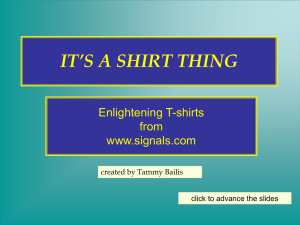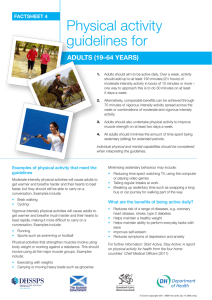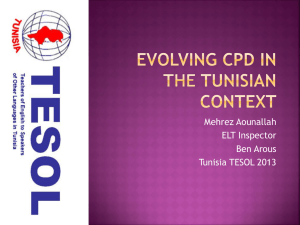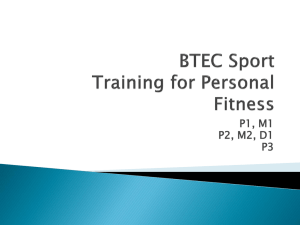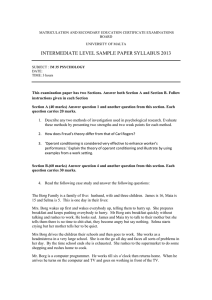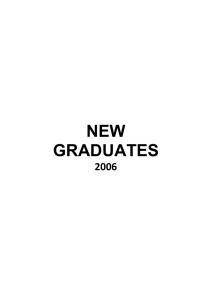+ PHYSICAL ACTIVITY FOR THE ELDERLY
advertisement
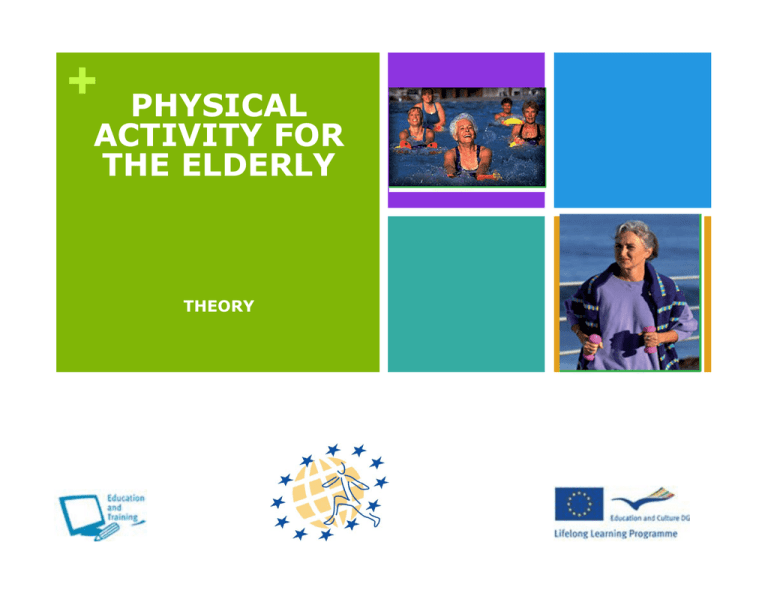
+ PHYSICAL ACTIVITY FOR THE ELDERLY THEORY Contents 1. Benefits of physical activity 2. Th problem The bl 3. 3 How o to increase c ease physical p ys ca activity? act ty 2 + THE BENEFITS OF PHYSICAL ACTIVITY Physical Activity (PA) “Any bodily movement associated with muscular contraction that increases energy expenditure above resting levels” 4 Æ Leisure time PA Leisure-time Æ Occupational PA Æ PA at or near the home Æ PA connected t d with ith transport t t BENEFITS OF PHYSICAL ACTIVITY Management of the disease Secondary Prevention Primary Prevention 5 Advantages of Physical Activity Prevents ¾ ¾ ¾ ¾ ¾ ¾ Diabetes Colon cancer Breast cancer Osteoporosis Falls and fractures Cognitive decay Prevents and heals ¾ Hypertension et al, NEJM 1991 ¾ Helmrich CoronarySP disease ¾ Thune StrokeI et al, NEJM 1997 I et al, al NEJM 1997 ¾ Thune Obesity Price RL et al, NEJM 1991 Brukner PD et al, MJA 2005 Brukner PD et al, MJA 2005 Brukner PD et al, MJA 2005 6 Loss of functional capacity with ageing Muscle resistance 1-2% per anno Muscle force Aerobic capacity 3-4% 3-4% per anno Bone density male Bone density female 1% 2-3% Flexibility and balance Proprioception and coordination Kinesthetic Perception 7 Temperature Regulation Imp o ement of quality Improvement q alit of life Physically y y Active Physically Inactive ‘Minimum necessary to perform activities of daily living Physical exercise i capacity 8 Age Adapted from Young (1986) + The Problem Physical activity O off the One th mostt important i t t human h functions Civilization reduces the need for ¾ ¾ 10 Human H man force Movement Agriculture Buildings g Transport Physical activity One of the most important human functions Today 11 ¾ ¾ In great measure eliminated We ignore its importance for health and well-being The Problem 12 40 – 60 % of the EU adult population leads a sedentary lifestyle 23 5 % is completely sedentary 23.5 No Physical Activity Poor muscle tone Risk of fractures Obesity Diabetes Premature Ageing 13 sleeping 0.9 METs cooking 2.0 METs Energy Cost 1 MET = 3.5 mL • kg-1 • min-1 V02 Running quickly on a flat surface Slow walking on a flat surface 12.0 METs 3.0 METs Relationship PA and mortality MET = Energy cost McAuley P et al. Am Hearth J 2006 15 + INCREASING PHYSICAL ACTIVITY Guidelines (1) World Health Organisation The objective Goal is to achieve a minimum of 30 minutes of moderate-intensity physical activity 5 days a week or at least 20 minutes of vigorousintensity physical h l activity 3 d days a week k Recommended in short bursts of 10-15 minutes 17 Guidelines (2) 30 minutes a day Æ prevention of chronic diseases 60 18 minutes a day Æ weight management How to increase physical activity? ti it ? Co nselling methods: Counselling methods 19 - Individually or in groups - In person, by telephone or via internet - Brief or intensive - Physical activity only or multiple behaviour changes (including smoking and diet) Behaviour Change Explain risks Motivate: why change? Goal setting: g How to change? 20 Problem Solving Treatment Goal setting: Specific: increase physical activity Measurable: 3 times a week for 30 minutes, 2 weekdays and one weekend day Achieveable: walking alone Relevant: walking Timetable: in the next week “W lk for “Walk f 30 minutes i three h times i a week” k” 21 Optimal is not achieveable Æ Optimum 3-4 times a week, 30-60 minutes a day High ÆNot intensity achieveable so: “Something” is better than “nothing” Moderate intensity y for a long g period p is better than high intensity for short Find something you can achieve eg. Walking, cycling Incorporate PA into your daily life, eg. Walk to p instead of g going g by y car the shop 22 Ask your doctor to help you How to increase physical activity? Type of PA: choose an activity you enjoy Æ greater effect PA in daily life: use the stairs instead of the lift All types of PA are effective: cycling, walking, tennis, golf etc Try to keep a balance: 2-3 times a week, every week Try 23 to find family or friends to join you Overall improvement in health Increase physcal activity Decrease dietary intake 24 Involve family and friends in your b h i behaviour change h Æ they th have h to t change h too HOW TO CHANGE PHYSICAL ACTIVITY? 1. Initial evaluation of possible risks and contro-indications (PAR-Q Questionnaire Aptitude for Physical Actvity) 2. Define an improvement plan with measurable objectives (PASA) FACTORS TO TAKE INTO CONSIDERATION TYPES OF EXERCISE Cardiovascular resistance Strength Balance Flexibility FREQUENCY AND TIME: see recommendations WHO (World Health Organisation) ACSM (American College of Sports Medicine) INTENSITY: Borg Scale MODERATE PHYSICAL EXERCISE Swimming Ping Pong Cycling Rowing Race cycling Dancing Gardening Golf Housework MORE INTENSE ACTIVITY Going upstairs, going for an uphill walk or in the hills/mountains Going for mountains Skiing Tennis Horseriding Swimming lengths of a pool Going trekking in the mountains a trip to the Examples of resistance activities Examples of resistance activities with moderate effort for the average elderly person Moderate: • Swimming • Going for a bike ride • Exercise bike • Gardening (digging,raking) • Quick walking on a flat surface f • Sweep or wash the floor • Tennis (in doubles) • Volleyball • Row R • Dance Resistance activities with more intense effort. Vigorous: • Climb the stairs or a slope • Shovel snow • Cycle up a hill • Tennis (singles) • Cross country skiing • Slope skiing • Running STRENGTH AND BALANCE Examples STRENGTH AND BALANCE Examples FLEXIBILITY FLEXIBILITY FREQUENCY AND DURATION OBJECTIVE 30 MINUTES of moderate physical activity 5 days per week 20 MINUTES of intense physical activity 3 days per week PROGRESSION gradually increase the frequency and duration INTENSITY BORG SCALE Least effort 6 7 Very very easy 8 9 Very easy 10 11 Easy 12 13 More or less difficult 14 15 Difficult 16 17 Very V difficult diffi lt 18 19 Very very difficult 20 Most effort Resistance activity Strength activity INTENSITY B Borg S l Scale GENERAL INSTRUCTIONS FOR USE OF THE SCALE (Rating of perceived exertion) 20 Most effort 19 E t Extremely l difficult diffi lt • While perfoming these exercises, we would like you to measure your percieved effort – how difficult the exrcise seems to you overall, not for any particular part of your body. • While doing a physicla activity, look at the scale which gos from 6 “no effort” to 20 “maximum effort”. • Choose the number which best describes the intensity level of your effort. This will give you a good d idea id off th the intensity i t it off effort ff t that th t you are carrying out, and you can use this scale to raise or lower the intensity of exercise so as to gain the required intensity. • Try to evalutae your level of effort as honestly as possible without thinking about the physical effort – it is your feeling of effort that counts, not how you compare to others. • Look at the scale and the numbers which correspond to the levels of inensity, then choose a number. 18 17 Very difficult 16 15 Difficult 14 13 A little difficult 12 11 Light 10 9 Little effort 8 7 6 Very little effort No effort Borg scale Go to your doctor if... You have chest p pain You feel dizzy Excessive breathlessness Irregular heartbeat Worrying y g symptoms y p INTENSITY According to the levels of physical activity, we can divide people into three groups. A different intensity level is recommended for each group. Sedentary (at the moment does not do physical activity) Partially Active (some physical activity but not that recommended by the WHO/ASCM) from 7 to 9 on the Borg Scale from 10 to 13 on the Borg Scale Active (follow WHO/ASCM recommendations) from 13 on the Borg Scale It is important to gradually increase the intensity! Borg Scale advanced d d partially active intermediate sedentary b i beginner BEGINNER (Example of Sedentary Profile) Sunday Monday Tuesday Wednesday Thursday Friday R i t Resistance R i t Resistance R i t Resistance 20 min. Walk From 7 to 9 Borg 20 min. Walk From 7 to 9 Borg 20 min. Walk From 7 to 9 Borg Saturday INTERMEDIATE (Example of Partially Active Profile) Sunday Monday Tuesday Wednesday Thusday Friday Resistance Resistance Resistance 30 min. Cycle 10 to13 Borg 30 min. Swim 10 to13 Borg 30 min. Cycle 10 to13 Borg Strength/ Balance 15 min. Stretching for the legs Stretching for the arms Strength/ Balance 15 min. Stretching for the legs Stretching for the arms Stretching for the legs Saturday ADVANCED (Example of Active Profile) Sunday Monday Tuesday Wednesday Thursday Resistance R i t 30 min Resistance R i t 30 min Resistance R i t 30 min Resistance R i t 30 min Stength/ St th/ Balance From 15 – 20 min Stretching 10 min Stretching 10 min Friday Saturday Resistance R i t 30 min Stength/ St th/ Balance From 15 – 20 min Stretching 10 min Stretching 10 min Stretching 10 min PRACTICAL PART 44 Practical Part (1) Activity in multidisciplinary groups: Groups of approx. approx 10 people Three sessions of 10 minutes One group leader for each group (a doctor, nurse, pharmacist or other expert) In groups, the participants discuss a case from real life. An example p is p provided for every y group g p (beginner, ( g , intermediate,, advanced). They are asked to decide whether the subject of the case study is a beginner, intermediate or advanced level. Distinguishing any risk factors they must then prepare an weekly programme adapted to their needs, with objectives, stages exercised to do and so on. See Handbook for additional details and solutions for Cases A, B and C. 21/03/09 Case study Case-study Case Study C St d A: A A woman off 65. 65 She Sh is i in i good d health h lth and d takes no medicine. She played volleyball regularly until the age of 25 and then gradually reduced her exercise. For the last 20 years she has hardly exercised exercised. Her motivation to start exercising again is that she has noticed a gradual weight gain over the last five years. Case Study B: A man aged 72. Slightly high blood pressure which is treated with medicines. He has always played sport and trained for it and has exercised irregularly for the last 20 years. He has decided to take up a regular programme of exercise to better control his blood pressure. Case Study Case Study C: A man aged 66. He is in good health and takes only oral hypoglycemic agent for a light . He has always y played p y competitive p sport p in the past p and still trains regularly, going to the swimming pool (twice a week) and to the gym (twice a week). He is motivated to follow a personalised exercise programme to improve the results obtained. b d Successful S f l Ageing A physically and mentally active life 48
